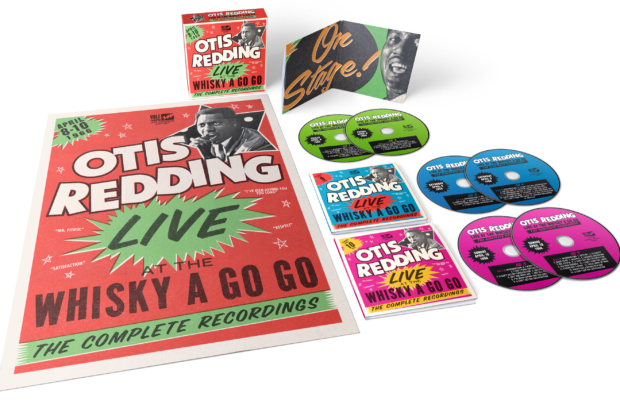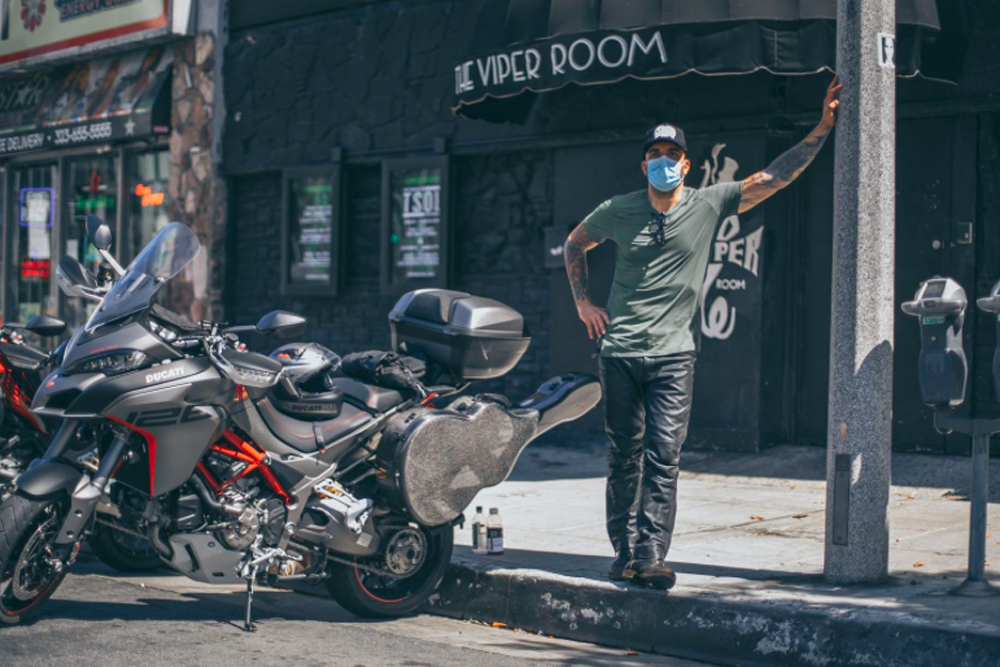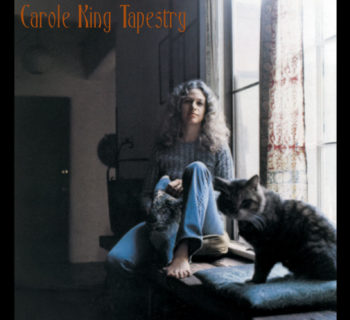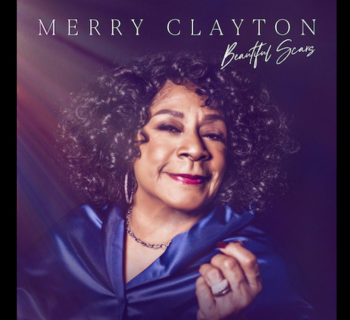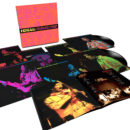In October of 1968 I held a copy of the Otis Redding Live at the Whisky A Go Go LP the first day it was available at Wallichs Music City in Hollywood. It was culled from Redding’s 1966 engagement at the landmark venue.
Over the decades it’s been reissued and re-released in various configurations, most recently in 2018, marketed as Live On The Sunset Strip, culled from three full sets of his Whisky A Go Go shows in 1966.
The current Live on the Sunset Strip edition is available on Stax Records label through Concord Music Group. The original album supervision was by Neshui Ertegun from the Whisky A Go Go April 9-10th 1966 club dates. The Rising Sons were the opening attraction.
This is a definitive live statement from Redding and songs are sequenced exactly as they went down. The collection includes some of Redding’s best-known songs: “I’ve Been Loving You Too Long,” “Security,” “I Can’t Turn You Loose,” “Satisfaction,” “Respect,” “These Arms of Mine” and “Just One More Day.”
For Otis Redding, a live recording in 1966 was a very logical career move: His manager and record label (respectively, Phil Walden and Volt, a Stax subsidiary) were seeking to further Redding’s crossover potential and expand his established audience.
Engineer Wally Heider, the West Coast’s leading recorder of live performances, was hired to tape three nights of Redding’s run at the Whisky—two sets on Friday, April 8, and three the next night and two on Sunday.
Located at the corner of Sunset Boulevard and Clark Street it was owned and operated by Elmer Valentine and Mario Maglieri, two former cops from Chicago. The Whisky had already initiated an integrated patron and live music booking policy that welcomed Otis and company with open arms.
In ’66, the club had booked the Otis Redding Revue and entourage which included an emcee and a full 10-piece band (led by saxophonist Robert Holloway) coupled with three up-and-coming singers who were allowed one tune apiece before he entered the famed Whisky stage in Hollywood.
Redding’s band for that long weekend were Holloway, Robert Pittman, Donald Henry—tenor saxophones Sammy Coleman, John Farris—trumpets Clarence Johnson, Jr.—trombone James Young—guitar Ralph Stewart—bass Elbert Woodson—drums
In the tradition of the R&B tours and whistle stops of the era, Redding also hand-picked some singing protégés including the keyboardist in his group, Katie Webster, Carl Sims and Kitty Lane for the club date.
On October 17, 1965 our Los Angeles radio station KHJ “Boss 30” record play listed “Respect” as number 14. The city was already deep into the Redding repertoire. R&B soul radio stations played Redding regularly and touted his anticipating visit to Sunset Blvd.
Two Otis Redding numbers—“I’ve Been Loving You Too Long (To Stop Now)” and “Respect”—had cracked the Pop Top 40, and a number of his recordings inspired covers by rock ’n’ roll bands, especially the Rolling Stones and his version of the group’s best-known song, “Satisfaction” was soaring up the singles charts in April 1966.
“I think Otis’ arrangement of ‘Satisfaction’ is more urgent than the Stones,” volunteered Dr. James Cushing, a now-retired Cal Poly San Luis Obispo English and Literature professor, who was a longtime deejay on KEBF-FM.
“I think Otis sings it more as a song of triumph than a song of frustration. What Otis does with it is that the person might not be satisfied but at least he has survived enough to tell the tale of his dissatisfaction. Whereas Jagger just sounds kinds of petulant and pissed off. Petulance and being pissed off is not bad either,” he added, “but it’s not a noble emotion and Otis was more noble.”
Just before his ’66 Whisky stint, Redding on April 2nd, performed at the Hollywood Bowl as part of a KHJ-produced “Appreciation Concert” to play both the Hollywood Bowl (as part of a KHJ-AM listener appreciation concert to benefit The Braille Institute of America.)
The Hollywood Bowl show included Donovan, Sonny & Cher, Bob Lind, the Knickerbockers, the Turtles, Jan & Dean, the Modern Folk Quintet and the Mamas & the Papas) and then his four-nighter at the Whisky A Go Go on the Sunset Strip.
Los Angeles music lovers and television children had already seen Redding in December 1965 when “Pain In My Heart” was broadcast in a TV performance on Dick Clark’s Where The Action Is. In addition, we caught “Just One More Day” from another Redding TV appearance the same day on Hollywood A Go-Go.
Occasionally, when Redding and other R&B acts played the Whisky venue in 1966-1970, I was outside the club as a young teenager. My local West Hollywood library was down the same street from the Whisky A Go Go on San Vincente Blvd.
The news was out that Otis was in Hollywood and I just wanted to see Otis Redding’s name on the Whisky A Go Go marquee. That was cool enough.
The concept of actually going inside the building without hassle was not even considered. I had to wait until I was age 18 when John Mayall & the Bluesbreakers and Savoy Brown shared a bill at the Whisky in 1969 before I was allowed to legally enter the house of worship.
In 1966, musicologist/drummer, and former Watts resident Paul Body, then bunking in Pasadena, and still one of my running buddies, lingered outside the Whisky hoping to catch a glimpse of Redding with our other soul music devotees.
“Otis at the Whisky,” exclaimed Body. “I remember that it was a Friday night and Gooler and I and maybe Joe George went cruising down Sunset on the prowl for foxes. We ended up at the Whisky, standing outside. At that time we couldn't get in because we were under age and didn't have any fake ID on us. We usually had some fake ID but on this night we didn't. That policy later changed. Anyway we just hung around outside and we could hear Otis Redding do his thing. It sounded great.
“As we were waiting outside, a car pulled up and out piled the members of THEM, they had been doing a residency thing at the Whisky. I remember that Van Morrison was the last one out the car. I amazed by how short he was. Through the Whiskey walls I could hear, ‘Respect’ and it was stomping. The doorman said that Dylan was inside. I like to think that that was the night that Dylan tried to turn the Big O on to ‘Just Like A Woman,’ which always sounded like a soul song to me anyway. It felt great that soul was coming to the Sunset Strip. I didn't get to see Otis until next year at the June Monterey International Pop Festival, and well, the rest is history.”
Music and record business veteran Robert Marchese once managed Body’s band, the Sheiks of Shake and was former manager of The Troubadour 1970-1983. Robert was a record producer, who won a Grammy for producing a live Richard Pryor album at The Troubadour.
“I saw Otis in Baltimore, Maryland at the Howard Theater,” recalled Robert, “on a Saturday night when he had ‘Pain In My Heart.’ end of 1963. I was in the military stationed in Ft. Mead, Maryland. I also saw him at the Royal Theater on Friday night. He was dynamic. One of the great shows I ever saw. He did not disappoint. It was a package of the top ten R&B acts on the soul charts and they would bring them in for the weekend and do a song each.”
Marchese then provided the run up to his next seismic physical encounter with Otis Redding.
“When the Otis ’66 Whisky shows announced I was parking cars across the street at the 9000 Building,” proclaimed Marchese, “and I told my boss I was going to the Whisky to see Otis. ‘Well you can’t.’ ‘I quit!’
“I had my uniform on and walked into the Whisky. I sat with Dylan and his entourage which I think included Robbie Robertson and D.A. Pennebaker. I knew Elmer Valentine who owned the club. Otis was as good as the album. The album is proof of the pudding. At the Whisky he was more sure of himself from ’63. He kicked everyone’s ass in,” Marchese confirmed.
In the spring of 1966, Otis Redding’s touring act was achieving historical notices and press cuttings.
Drummer turned record producer/manager, Denny Bruce, an avid R&B fan, who played with the pre- Freak Out Mothers, and then guided the careers of Leo Kottke, John Fahey, John Hiatt, the Fabulous Thunderbirds and longtime associate of Jack Nitzsche, later jamming himself with Taj Mahal one night at The Ash Grove, also caught Redding and his team blast at the Whisky.
“I was amazed to see how big Otis was in person,” exclaims Denny. “I went as a paying customer and stood on the dance floor for this epic stand. It was a relief to see the real thing in person after the Enemies and the Leaves in that room.”
Redding was an instant phenomenon and his local ’66 shows did not go unnoticed by reviewer Pete Johnson of The Los Angeles Times.
In his headline review, “Otis Redding’s Southern-Style Blues Band Lets Off Steam,” Johnson wrote: “Drawn by his growing popularity, a fervid audience shoe-horned into the club, chorused in on some of his songs and at one point interrupted his introduction of a ballad by clamoring for more of his fast paced tunes. Redding was assured of an In Group [sic] following Thursday night when from among his spectators emerged Bob Dylan, trailed by an entourage of camp followers.”
(Reportedly, Dylan offered Otis “Just Like a Woman” as a possible cover that night, though Redding thought the song was a little wordy.)
In May 2010, Pete Johnson emailed about witnessing cosmic comet Redding.
“I loved Otis Redding very much both as a recording artist and as a performer. I saw him twice: at the Whisky and at the Monterey International Pop Festival. They were both magnificent performances. Like Ray Charles, he could slow down and elaborate a blues piece, morphing it from a song to a dramatic performance. ‘I've Been Loving You Too Long,’ for instance, with its stately horn figures and his vocal agony stretched thin.
“Similar to, but quite different from, Ray Charles' slow-motion live versions of ‘Drown in my own Tears’ and ‘A Fool for You,’ where time stands still as Ray duets with his piano, building toward the horns and the Raelettes. And then Otis could stomp on the accelerator and rip through ‘I Can't Turn You Loose,’ a rock & roll locomotive. At this point I can't remember how they crammed his band onto the Whisky stage. The Whisky hosted lots of great performances. This was up near the top.”
For the August 21, 1976 issue of Melody Maker I interviewed Jerry Garcia, Carlos Santana and promoter Bill Graham at Graham’s Mill Valley Northern California home.
I asked Bill about his favorite concert performer and without hesitation he ranked Otis as “The single most extraordinary talent I had ever seen.”
But initially, promoter Graham stressed was that he had to first fly from San Francisco to Macon, Georgia to personally convince Redding to play his fabled rock palace with the eighteen- piece Robert Holloway band.
How could Graham describe Redding on his stage?
“A six foot three black Adonis in a green suit, a black shirt and a yellow tie who moved like a serpent or a panther stalking his prey.”
There was a documented triumph for Redding on the Stax/Volt tour of Europe and England the following March. Then the game-changing spot in June 1967 at the epochal Monterey International Pop Festival coupled with Aretha Franklin re-working his tune “Respect” that dominated the R&B and Pop radio airwaves all summer and fall.
And tragically, on December 10, 1967, came Redding’s death with four members of his backing band the Bar-Kays when his airplane crashed in a Madison, Wisconsin Lake.
Various Redding-driven vinyl, tapes and CD’s have been available on the market since Redding’s physical demise and a certain amount of care and sensitivity has been employed by Stax and the label’s distributors and various catalog owners.
The original Redding LP In Person at the Whisky A Go Go I purchased in 1968 housed ten selected titles that contained Pete Johnson liner notes.
A 1992 version was shipped to retailers: Good to Me: Recorded Live at the Whisky, Vol. 2 in an expanded format from a hard-to-find 1982 release, which implemented additional tracks and emcee introduction.
The original supervision on these discs disc and a 2010 Redding Stax/Concord Music model lists Neshui Ertegun in the credits. He was either in the recording truck with engineer Wally Heider at the Whisky, or assembled the tapes later in New York at the Atlantic Studios.
Ertegun was no stranger to Los Angeles, either.
Nesuhi Ertegun in 1951-54, worked in Los Angeles for Lester Koenig’s Contemporary Records, and penned liner notes on a couple of Barney Kessel albums for the Contemporary label. He taught the first history of jazz course at UCLA that garnered academic credit at a major United States university.
Ertegun was about to work for LA- based Imperial records before brother Ahmet and Jerry Wexler persuaded him to join Atlantic Records. He was VP of the jazz and LP department and actively involved in their R&B recordings.
2018’s Otis Redding & His Orchestra Live On The Sunset Strip should now be considered the true, official, historical and spiritual audio document of Otis’ three consecutive sets that have now been fully unearthed and sequenced as this seminal Hollywood event occurred.
“I played the initial LP pressing on my radio show,” Dr. Cushing offered. “If you spin it on good equipment you can tell different songs were taken from different shows so there are obvious differences in sound quality. Some songs with almost no bass, others with a fair amount of bass. I’m sure they were working out the logistics on the recording end as Otis’ Whisky shows happened.
“The recording got better as the gigs progressed,” reinforced Dr. Cushing.
“Otis’s voice sounds really good on all the tracks, front and center. What a wonderful rhythmic improviser he is in terms of his voice, in terms of way of his delivery. It is his best live album but the instruments are a little inconsistent.
“I loved hearing brass at The Whisky. It’s Otis at The Whisky! The club then and now had great sight lines and great acoustics. There were seats on the dance floor level, too. And you could see everything well, even from the balcony on top. The sound system, then and now, always state of the art. The idea of somebody there like Otis Redding who had that stadium size charisma, with a full band and horn section…
“I’m so happy about the new remastered album,” he reiterated. “There is more emphasis on the drum sound. On the original it was equalized little far down. The addition of added tracks and material is fine,” he marveled.
“The extra minutes now added do not dilute the initial configuration. I don’t feel the intention has been violated because the original intention had to do with finding the retail market and with finding a balance between the music as music and the music as LP. The restrictions of what it could hold on each side of the vinyl.
“But now with the expanded playing time of CD’s and the whole computer mp3 thing, I feel that with this 2018 Redding at the Whisky A Go Go model we are getting a much more accurate picture of our own cultural past. With all its richness, liveliness, humor and all of the human touches now inserted.”
In my 1999 interview with teacher, philosopher, and author Ram Dass, we discussed the role of music and specific live events on our existence.
“How can we use this gathering as an exercise in order to help ourselves on the way? This is nothing else to do anyway but become enlightened,” explained Ram Dass.
“We can retain a degree of consciousness throughout this whole experience in which we see it as an experience instead of collecting experience. It’s just ‘I’ll be here and dig this whole drama unfolding.’”
Harvey Kubernik is the author of 19 books, including Canyon of Dreams: The Magic and the Music of Laurel Canyon and Turn Up The Radio! Rock, Pop and Roll in Los Angeles 1956-1972.
Sterling/Barnes and Noble in 2018 published Kubernik’s The Story of The Band From Big Pink to the Last Waltz. Harvey is currently writing and assembling a summer 2021 book on Jimi Hendrix for the same publisher.
Otherworld Cottage Industries in late July 2020 published Harvey’s 508-page book Docs That Rock, Docs That Matter. Kubernik interviews with D.A. Pennebaker, Albert Maysles, Murray Lerner, Morgan Neville, Sandra Warren, John Ridley, Michael Lindsay-Hogg, Andrew Loog Oldham, Curtis Hanson, Dick Clark, Allan Arkush, and David Leaf, among others.
In 2020 Harvey served as Consultant on Laurel Canyon: A Place In Time documentary directed by Alison Ellwood which debuted on the EPIX/M-G-M television channel.
Harvey Kubernik’s The Doors Summer’s Gone was published by Otherworld Cottage Industries in February 2018. It was nominated for the 2019 Association for Recorded Sound Collections Awards for Excellence in Historical Recorded Sound Research.
Kubernik’s writings have been in several book anthologies, most notably The Rolling Stone Book of the Beats and Drinking with Bukowski. He was the project coordinator of the recording set The Jack Kerouac Collection.
Harvey’s 1995 interview, Berry Gordy: A Conversation With Mr. Motown is in The Pop, Rock & Soul Reader edited by David Brackett published in 2019 by Oxford University Press. Brackett is a Professor of Musicology in the Schulich School of Music at McGill University in Canada. Harvey joined a lineup which includes LeRoi Jones, Johnny Otis, Ellen Willis, Nat Hentoff, Jerry Wexler, Jim Delehant, Ralph J. Gleason, Greil Marcus, and Cameron Crowe.
Kubernik in 2006 spoke at the special hearings initiated by The Library of Congress that were held in Hollywood, California, on archiving practices and audiotape preservation.
Kubernik has penned a book jacket endorsement for author Michael Posner’s upcoming volume on Leonard Cohen that Simon & Schuster, Canada, will be publishing during October 2020, Leonard Cohen, Untold Stories: The Early Years.

